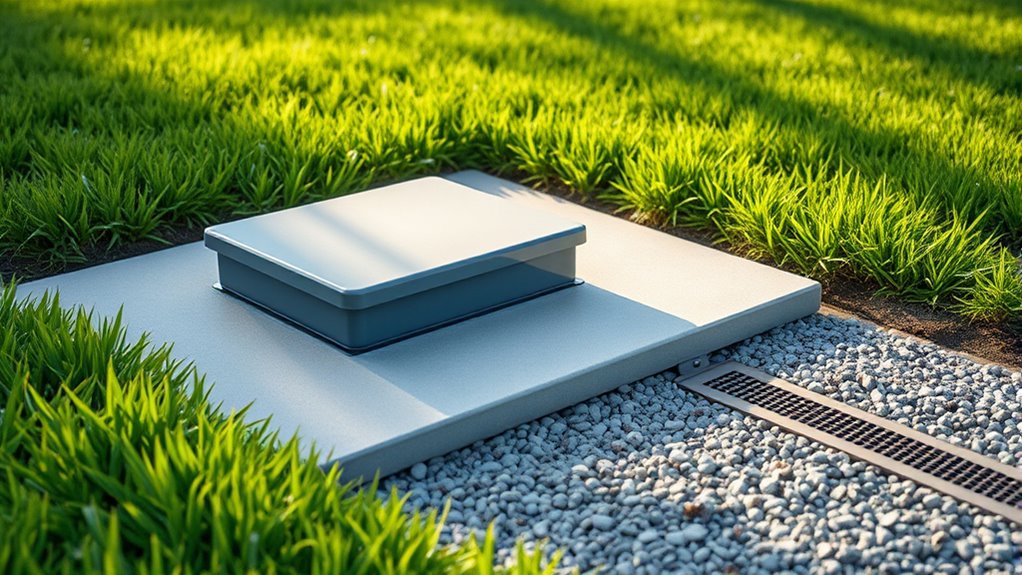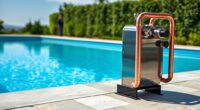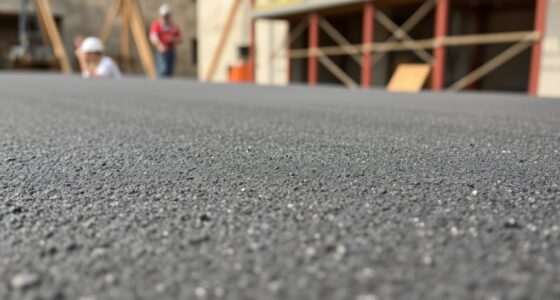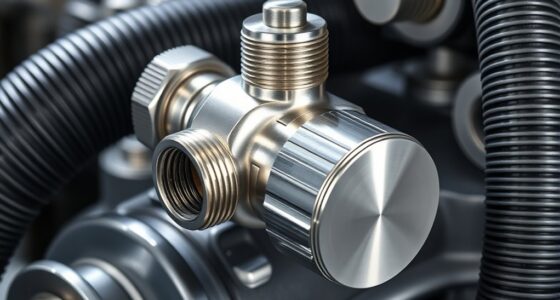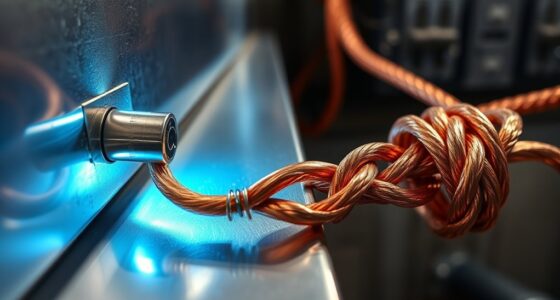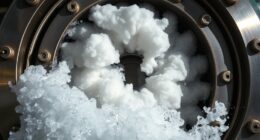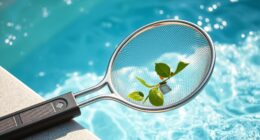To keep your equipment pad dry and neighbor-friendly, guarantee proper site grading with at least a 2% slope away from the pad, preventing water pooling. Install effective drainage solutions like French drains or gravel beds, and regularly clear debris. Select quieter equipment and position it away from property lines. Use barriers or sound-enclosing walls to reduce noise. Proper maintenance of drainage and soundproofing methods will help you manage these issues efficiently—learn more to enhance your setup.
Key Takeaways
- Ensure proper site grading with at least a 2% slope away from the equipment pad to prevent water pooling.
- Install drainage solutions like French drains or pipes to redirect excess water and maintain dryness.
- Use sound barriers, enclosures, and equipment with noise-reduction features to minimize noise disturbance to neighbors.
- Regularly inspect and maintain drainage systems, seals, and barriers to ensure ongoing effectiveness.
- Position equipment thoughtfully, away from property lines, and elevate on pads to reduce vibrations and noise impact.
Ensuring Proper Site Grading for Effective Drainage
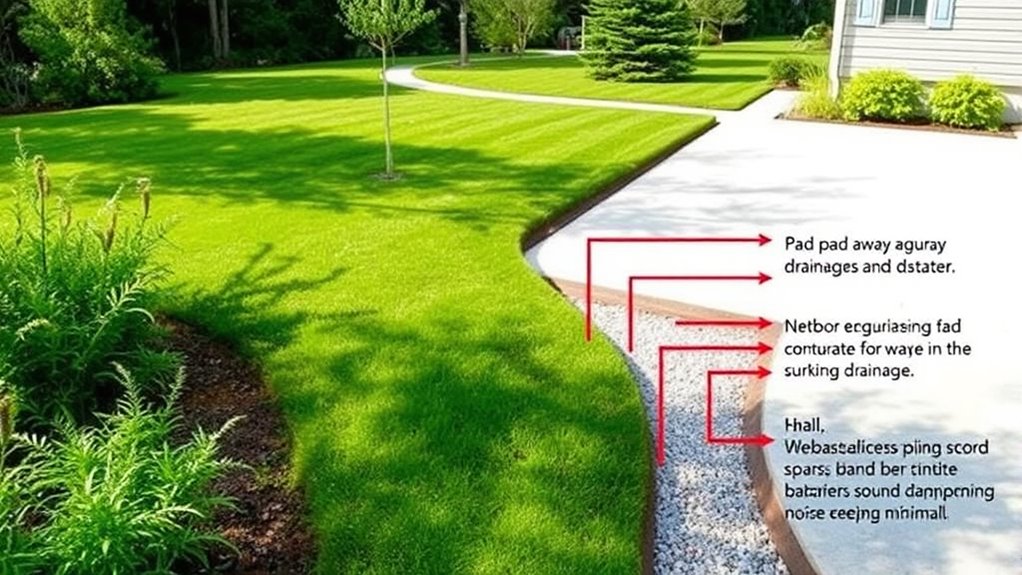
To guarantee effective drainage around your equipment pad, you need to prioritize proper site grading. Start by ensuring the land slopes away from the pad’s edges, directing water runoff away from your equipment. A gentle slope of about 2% is ideal, which means a drop of 2 feet over 100 feet. Use a level or a laser tool to check the slope accuracy during grading. Avoid flat surfaces or low spots that can trap water, leading to pooling or flooding. Proper grading prevents water from seeping into the pad’s foundation, reducing the risk of damage and corrosion. Regularly inspect the site after heavy rains to confirm the grading remains effective and adjust if necessary. Good site grading is the foundation of a dry, well-functioning equipment pad. Monitoring water flow and drainage efficiency is essential for long-term system performance.
Installing Drainage Solutions to Prevent Water Accumulation
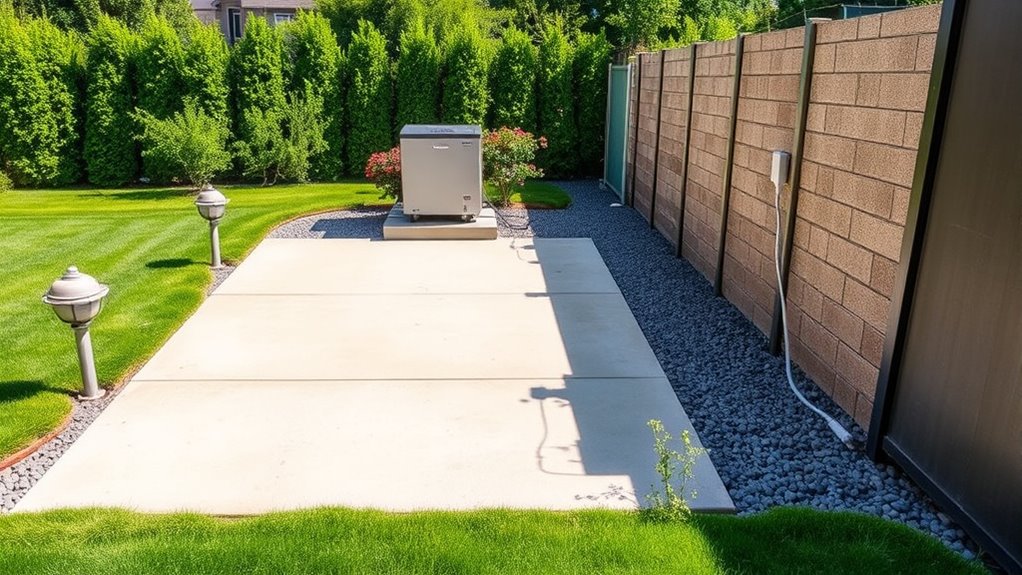
Installing effective drainage solutions is essential to prevent water from pooling around your equipment pad. Start by grading the ground away from the pad at a slope of at least 2%, ensuring water flows away naturally. Consider installing a drainage pipe or French drain beneath the surface to redirect excess water. Using gravel or crushed stone around the pad can improve infiltration and reduce surface runoff. Seal any cracks or gaps in the pad to prevent water infiltration and pooling. You might also install a surface drain or a catch basin to collect runoff before it reaches the equipment. Regularly inspect and maintain these systems to ensure they remain functional. Proper drainage keeps your equipment dry, reduces the risk of damage, and minimizes water-related noise and disturbance. Additionally, understanding the art of Italian espresso can inspire you to create a cozy, functional outdoor space that complements your coffee setup.
Choosing and Positioning Equipment to Minimize Noise Pollution
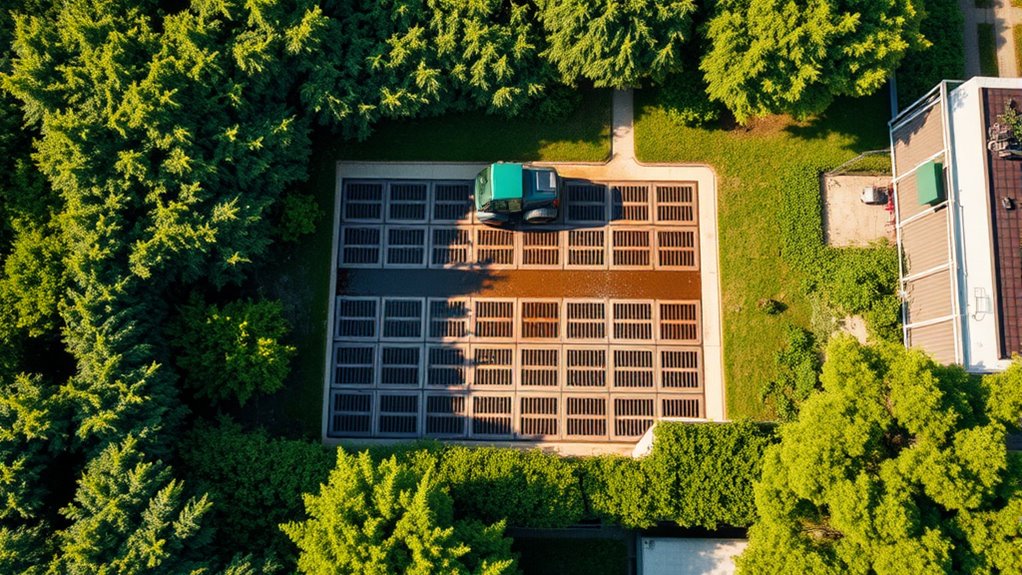
Choosing the right equipment and placing it strategically can substantially reduce noise pollution around your site. Start by selecting quieter models or equipment with noise-reduction features, such as mufflers or sound-dampening materials. Position heavy machinery away from property lines and neighboring structures whenever possible, creating natural buffers. Elevate or isolate equipment on pads to minimize vibrations that contribute to noise transmission. Consider the direction of airflow and sound, placing equipment so noise is directed away from sensitive areas. Regular maintenance also plays a role—well-maintained equipment operates more quietly. Additionally, using noise mitigation strategies can further enhance noise reduction efforts. By carefully selecting and positioning your equipment, you can considerably cut down on noise, helping to maintain good neighbor relations and comply with local noise regulations.
Using Barriers and Enclosures to Contain Noise
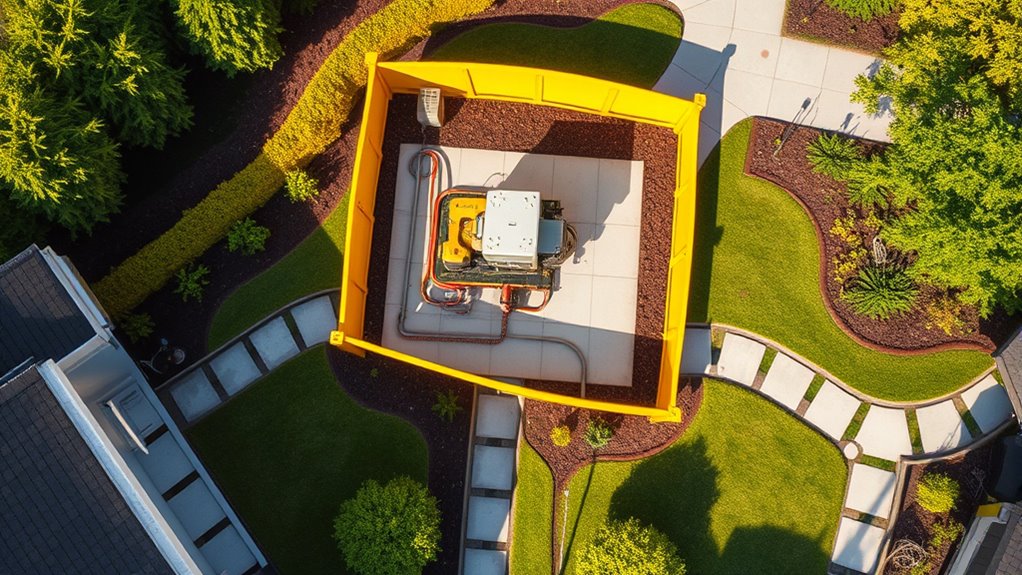
Using barriers and enclosures is an effective way to contain noise and prevent it from spreading beyond your site. Installing solid barriers, like fences or walls, around equipment pads creates a physical barrier that absorbs and blocks sound waves. Enclosures made from sound-absorbing materials can also decrease noise levels markedly. Ensure that these barriers are tall enough and positioned close to noisy equipment to maximize their effectiveness. Proper placement helps dampen sound before it reaches neighboring properties or public spaces. Remember, the goal is to create a barrier that minimizes noise escape without obstructing airflow or access for maintenance. Incorporating sound-absorbing materials into your enclosures can significantly enhance their noise-reducing capabilities. By carefully designing and installing these enclosures, you can keep noise levels down, improve neighbor relations, and maintain a quieter, safer work environment.
Maintenance Tips for Long-Term Drainage and Noise Control
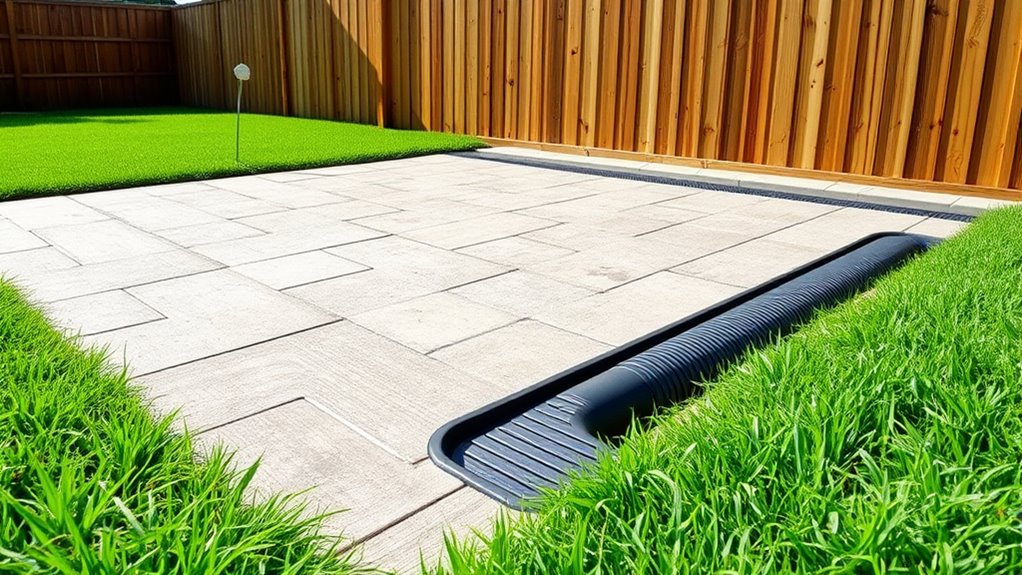
Regular maintenance of barriers and enclosures is key to guaranteeing they continue to effectively contain noise and support proper drainage over time. Regular inspections help you identify cracks, loose fittings, or blockages early, preventing bigger issues later. Keep drainage paths clear of debris and vegetation to avoid water pooling or flooding. Check seals and joints to maintain effectiveness against noise leaks. To illustrate, consider the following:
| Inspection Tasks | Frequency | Purpose |
|---|---|---|
| Visual check for damage | Monthly | Detect wear and tear |
| Clear debris from drains | Weekly during rainy season | Maintain flow and prevent backups |
| Tighten fittings | Quarterly | Ensure structural integrity |
| Seal cracks or gaps | Annually | Preserve noise containment and drainage efficiency |
Additionally, incorporating vibrational energy awareness can support the longevity of your setup by promoting a positive environment that aligns with your maintenance goals. Consistent upkeep maximizes your setup’s lifespan and neighbor friendliness.
Frequently Asked Questions
What Are the Environmental Impacts of Poor Drainage Around Equipment Pads?
Poor drainage around equipment pads can lead to environmental issues like soil erosion, water contamination, and habitat damage. You might notice increased runoff, which can carry pollutants into nearby water sources, harming aquatic life. It also risks flooding, damaging the equipment and nearby land. By ensuring proper drainage, you help protect the environment, prevent pollution, and maintain the safety and integrity of your site and surrounding ecosystems.
How Do Climate Variations Affect Drainage and Noise Control Strategies?
Imagine your equipment pad as a quiet pond; climate swings can stir the waters. Heavy rain, drought, or freezing temps alter how water flows and drains, so you need flexible strategies. You might add adjustable drainage systems or sound barriers that adapt to weather shifts. By staying proactive, you keep noise levels neighbor-friendly and ensure your setup stays dry, no matter the climate’s mood swings.
Are There Specific Regulations Governing Noise Levels From Equipment Pads?
Yes, regulations do govern noise levels from equipment pads. You should check local ordinances and zoning laws, as they often specify maximum permissible sound levels, especially during certain hours. Make sure your equipment complies with these standards to avoid fines or neighbor complaints. Installing noise barriers or using quieter equipment can help you stay within legal limits and maintain good relationships with your neighbors.
Can Landscaping Be Used to Naturally Reduce Noise and Improve Drainage?
Think of landscaping as nature’s sound barrier and sponge. Yes, you can use plants, shrubs, and trees to naturally reduce noise by absorbing and blocking sound waves. Additionally, strategic landscaping with permeable ground cover, such as gravel or mulch, helps improve drainage by directing water away from equipment pads. By creating a lush, layered barrier, you’ll keep noise levels down and guarantee proper drainage, making your space more neighbor-friendly and functional.
What Safety Precautions Should Be Taken During Installation and Maintenance?
You should wear proper safety gear like gloves, eye protection, and earplugs during installation and maintenance. Always disconnect power before working on equipment to prevent shocks. Use tools correctly and follow manufacturer instructions carefully. Make sure the area is clear of bystanders and secure loose parts to avoid accidents. Regularly inspect for hazards such as sharp edges or unstable surfaces. Staying vigilant helps protect you and others during these tasks.
Conclusion
By properly grading your site, installing effective drainage, and choosing the right equipment, you can keep your equipment pad dry and neighbor-friendly. Adding barriers and maintaining the setup guarantees long-term success. Think of it as gardening—you nurture the environment around you, preventing problems before they grow. With these steps, you’ll create a peaceful, dry space that’s as reliable as the sunrise, ensuring harmony with your neighbors while protecting your investment.
